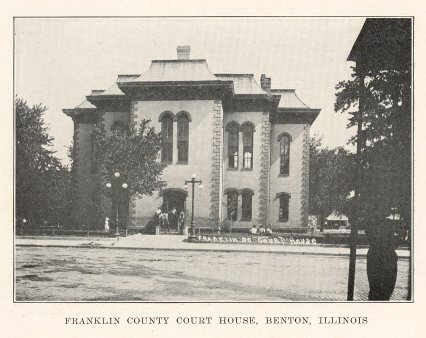
Pg 82
cans often elect part of the ticket. The present supervisor is Frank Easley.
During the session of the legislature of 1839, Franklin County was divided near the center north and south. The south half was formed into a new county called Williamson. The county-seat had been from 1826 at Old Frankfort on the Hill, but it was now quite evident that a new location for the county-seat would be selected. Walter S. Aiken and John Ewing secured land near the center of the territory of Franklin County so as to be able to get in on the "ground floor" of the new town.
The act of the legislature, dividing the county, also named commissioners to locate the new county-seat. Milton Carpenter of Hamilton County, Noah Johnson of Jefferson County and John Reid of Perry County were named as the commissioners to locate and name the new county-seat.

Pg 83
These commissioners met at the home of Abraham Rea and after being duly sworn, began to view the several sites in and around the center of the county, -Swofford site, two miles of Benton, Ewing site near Rawling's Prairie, and Rea site south of Benton. They finally decided on the land "on the summit of a mound or hill on the edge of the timber, and at the south end of Rawling's Prairie." This land was owned by Walter S. Aiken and John Ewing. The owners agreed to give twenty acres. The commissioners set up a stake at the root of a forked hickory tree which was to be the center of the track. The forked hickory tree stood in the center of the square, and in the center of the present court-house. The site was covered with hazel brush and hickory trees.
Braxton Parrish says in his noted lecture that he had chased a bear over the site where Benton now stands. This new town was named "BENTON" in honor of the famous Missourian - Thomas H. Benton - who for thirty years was a United States Senator from Missouri. The land donated
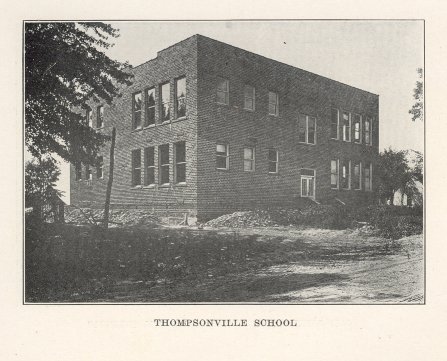
Pg 84
to the county for the new county-seat was surveyed and laid out into lots.
The lots were sold for the purpose of building a courthouse and other public buildings. The aggregate of the lot sales on the public square was $2,620.62 and the contract for the building of the first court-house and clerk's office was awarded to Augustus Adams for $539.50.
The second court-house was built in 1845, and was the first brick house erected in Benton.
In the sales of town lots on the square it was found that Abraham Rea manifested an anxiety to buy Lot 38, where the Swofford building now stands. It was supposed that the hill on which Benton was located was dry and would be difficult to find a well of water. This lot-No. 38-had a well on it so the price paid for it was $235.00, while the price of the others on the square ran from $15.00 to $50.00 for business lots.
Here on this lot Mr. Rea put up the first improvements
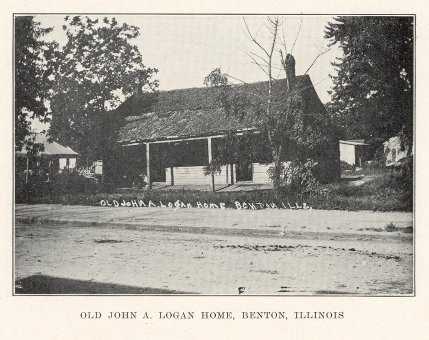
Pg 85
aside from the court-house and Clerk's office. The house was a round log house 14 x 16 feet, in which to keep a grocery. Then a grocery meant a place to sell liquors. Later, Augustus Adams built a log house where the Hart block now is, for a grocery. These were the first business houses in the town of Benton. The next improvement in the town was a frame, built by J. F. Knox and Walter S. Aiken on Lot No. 24, where the new First National Bank building is being erected. Then later these parties extended the buildings to the alley, near the Hudson Hotel which was called the "White Row." The first hotel in the town was erected and kept by Wm. R. Browning, where the Noyler building now stands. The prices charged at these hotels were liberal, indeed, for a meal only 10 cents and for supper, bed and breakfast twenty-five cents. Cornbread was mostly used then.
The first merchants of the town were Knox and Aiken, Wm. R. Browning, Tilman B. Cantrell and A. D. Wilbanks. The store opened up by Welbanks was considered the largest
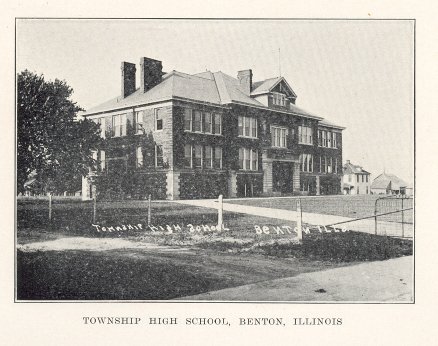
Pg 86
store in the county. It was more spacious than the other stores, but had only about $1,000.00 in goods. Levi Browning built a sawmill in 1853, and later put in burrs.
Up to 1869 there was not a brick house in Benton except the court-house. The old bank building of the First National Bank and the Ward and Mou. block on the south side were the first business brick houses. This was built by John J. St. Clair, who also built the present court-house and the Logan School building, which was torn down in order to build another more commodious.
At first the houses on the square were wooden buildings, but in the course of time these gave way to substantial brick buildings, and now the square is built up with large, commodious brick structures. At present one of the largest buildings, south of Springfield, is being erected on the north side of the square.
The early lawyers of Benton were W. B. Scates, Hugh Montgomery, Wm. A. Denning, J. H. Mulkey, John A. Logan,
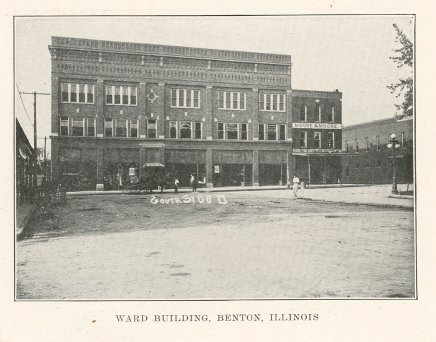
Pg 87
M. C. Crawford, Wm. K. Parrish, A. D. Duff, F. M. Youngblood and S. E. Flannigan; the early preachers were Rev. Braxton Parrish, T. M. Vance, Robert Moore and Moses Neal.
The early doctors were Drs. W. O. Espy, F. M. Sams and W. D. Burgess.
The first school in Benton was opened in 1841. The legislature incorporated the Benton Academy in 1841 and named some of the citizens as trustees. The trustees purchased a lot and built a two story frame building. The academy did not survive long. Then the trustees sold the property to the Benton school district and on the lot sold, was erected in 1870, the first brick school building in the county. The building received the name of Logan in later years. The old frame school house was moved about a block east on Church street and at present is occupied by Wilson Dillon, as a residence.
The oldest newspaper in Benton or Franklin County is the Benton Standard, established in 1849 by Tilman B. Cantrell. A. E. Martin is the present editor. The Franklin County
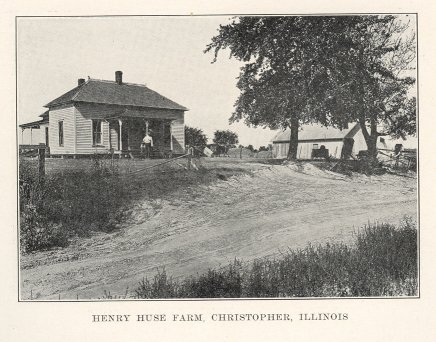
Pg 88
Chronicle established in 1879 by John A. Wall, was destroyed by fire in 1890. The Benton Republican was established in 1894 by James S. Barr. H. L. Frier is the present editor.
Benton has seven churches. The first Baptist church was organized in 1841 through the efforts of Elder T. M. Vance. This church is the strongest Baptist church in Franklin County. Dr. W. P. Throgmorton was for many years pastor of this church. Its present membership is 550 and Rev. J. L. Meads is the present pastor.
The Methodist church of Benton was organized about the year 1852, through the efforts of Rev. Braxton Parrish. The Methodist church has had a line of very eminent divines from the time of its organization to the present time. Its present pastor is Rev. L. S. McKowen.
The Christian church was organized in the winter of 1888. Their church building was destroyed by fire. A lot on the next block south was secured and one of the best church edifices in Southern Illinois has been erected. The Christian church
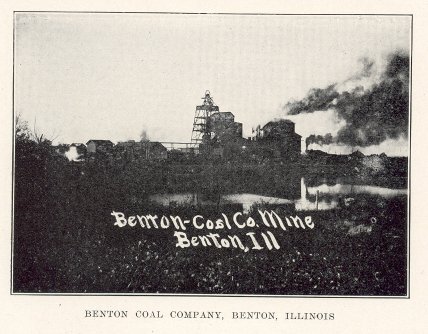
Pg 89
is strong in membership. Rev. P. H. Robertson is the present pastor. There are two regular Baptist churches on Webster Avenue and a Catholic church in the west part of the city. West City has a Baptist church called Prospect.
Benton has four large department stores. C. E. Seeber, in the Ward building in the southeast part of the square, does a very large business. E. B. Nolen, located on the west side of square has an excellent department store. Moore and Moore, on the south side of square has an up-to-date department store.
Benton has three large lumber yards; Stotlar, Herrin
Lumber Co., located on North Street; W. L. Eskew Lumber
Co. on South Street and Smith Lumber Co. near the C. & E.
I. depot.
The first bank organized in the county was known as the bank of Ward and Moore. Later this bank merged into the Benton State Bank and located on the east side of square. This bank has a capital stock of $50,000.00. Capt. Carrol

Pg 90
Moore is president. R. R. Ward, W. B. Blake and W. W. McCreery are vice-presidents.
The First National Bank was organized in 1899. Its capital stock is $50,000. W. W. McFall is president, Jesse Dimond vice-president and C. C. Cantrell, cashier.
The Mercantile Bank and Trust Co. was organized in 1912, with capital stock of $25,000. A. S. Cleveland is president and W. R. Browning is vice-president, N. S. Helm, cashier.
There are two large hardware stores in Benton. The McFall Hardware Co. located on north side of square is perhaps the largest business of its kind in Southern Illinois. The Campbell Hardware store on the southeast corner of square does a flourishing business.
Benton is blessed with three good hotels and could use more to great advantage. Hudson Hotel, established by Joseph Hudson, is located on the northeast corner of square. Bennett's Hotel on East Street is a European hotel. There are
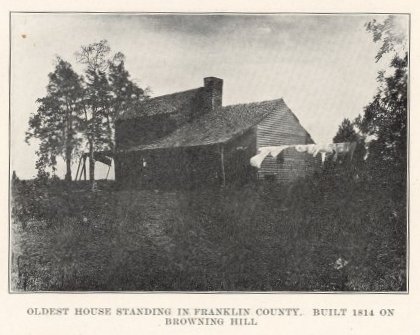
Pg 91
several cafes that are up-to-date and do a big business. Allen's cafe on East Street and Jed's cafe in McCreery's block, southeast corner of square, are the leading cafes.
The A. D. Jackson Saddlery Co. is one of the oldest institutions of its kind in Southern Illinois. It was organized by A. D. Jackson in a very early day. The old frame buildings were burned in 1896 and a large and commodious structure was erected to house the factory. This company manufactures more harness and collars than any institution of its kind in the Middle West.
The first brick buildings on the square were built in 1870. These were the Moore building, where Moore and Moore's store is now and the First National Bank building. The next brick structure was the bank building of Ward and Moore adjoining the Moore building. The brick buildings next put up were the Hoskinson and H. Swoffords block on the east side of square about 1884, and the Mitchell building about 1890. The Odd Fellows erected the building, where Campbell's hardware store is now, about 1886.
The McFall block was next in the order of development, about 1894. The Naylor building came in about this time. The A. D. Jackson Saddlery Co. buildihg was erected in
1897-8. The Hudson Hotel was next in order of development and the Garragus building and the Joplin block followed soon after this.
The Duppe building, Fitzgerrell block, Dr. Joe Moore building and Mrs. Charley St. Clair building came in close together, also the C. A. Jackson. The Hart block, first built by Geo. Hubbard, then more added to it, was another great improvement on the west of square, south of west Main Street. The Benton State Bank building was erected about 1902. The Browning block and the Mrs. E. H. Swofford building came next in order. The Ward building was the largest building of any on the square.
The McCreery block on the southeast corner was quite an